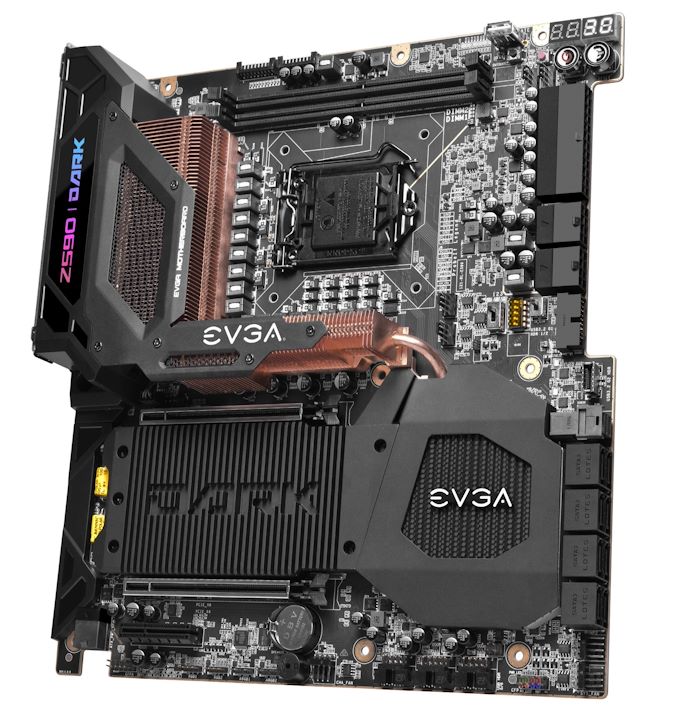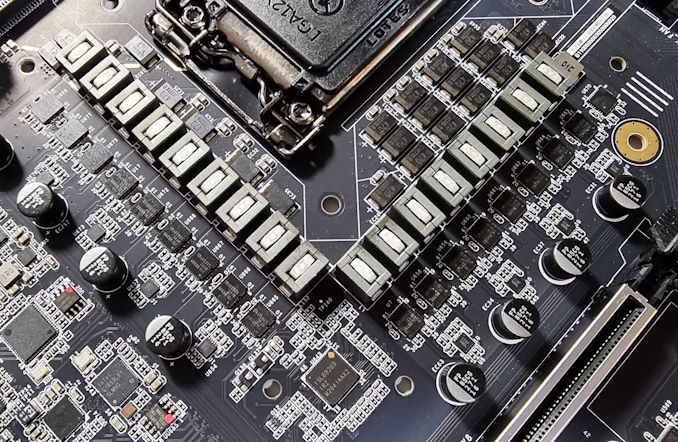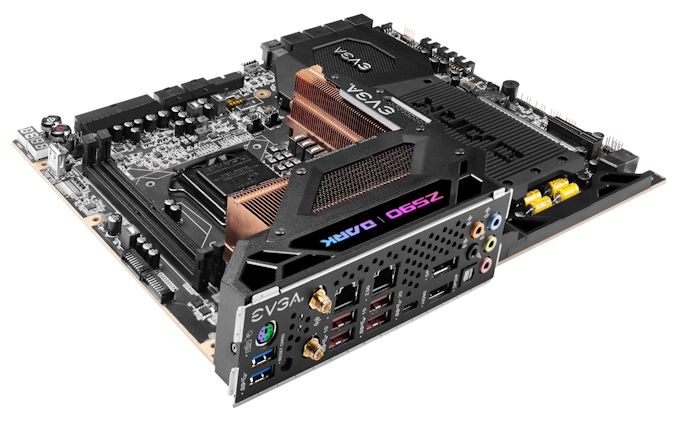The EVGA Z590 Dark Motherboard Review: For Extreme Enthusiasts
by Gavin Bonshor on October 15, 2021 9:00 AM ESTConclusion
We recently reviewed EVGA's first AMD Ryzen motherboard, the X570 Dark, and we were highly impressed with the performance levels on offer. Now it's our time to see how EVGA does in more familiar territory – Intel motherboards – and give our thoughts on the Z590 Dark. Ultiamtely we're looking at an enthusiast-grade motherboard designed for pushing CPUs beyond their limits on extreme cooling methods, and not many motherboards are capable of that.
Many of the EVGA Z590 Dark's features are aimed at overclocking, including an overclocker's toolkit with plenty of features to talk about. Particular highlights include a three-way BIOS selector switch – yes, this board has three BIOS ROM chips if a user manages to corrupt two of them. As well, it offers a slow mode dip switch, PCIe on or off dip switches, and a pair of EVGA Probelt voltage monitoring headers. Even the transposed LGA1200 CPU socket is mounted this way to aid overclocking, as this allows extreme overclocks better access to mount CPU pots.
Above the socket is a pair of horizontally mounted memory slots supporting DDR4-5333, with a maximum combined capacity of 64 GB. EVGA also includes an LN2 mode within the firmware that helps alleviate cold boot bugs when using sub-ambient cooling methods. This also allows for more CPU VCore to be put through; this isn't meant for everyday users, and only experienced users should play about with these settings.
Despite being an overclocking-focused motherboard, the Z590 Dark has plenty for regular users, as well. This includes three M.2 slots, a PCIe 4.0 x16 slot, one PCIe 3.0 x4, and one PCIe 3.0 x4 with support for SATA drives. Unfortunately, the third M.2 slot does share bandwidth with the half-length PCIe 3.0 x4 slot, but EVGA includes two full-length PCIe 4.0 slots operating at x16 and x8/x8 to satisfy users. Other storage options include a PCIe 3.0 x4 U.2 slot, which is rare in and of itself, and a total of eight SATA ports, six of which support RAID 0, 1, 5, and 10 arrays.
For connectivity, EVGA uses dual Intel I225-V 2.5 GbE controllers and an Intel AX201 Wi-Fi 6 CNVi, which provides plenty of options. We're a tad disappointed EVGA didn't include Wi-Fi 6E for the price, and we're not sure why it didn't. However, it does have one of Z590's natively supported USB 3.2 G2x2 Type-C ports, along with four USB 3.2 G2 Type-A and two USB 3.2 G1 Type-A ports on the rear panel. Audio is also decent, with a Realtek ALC1220 HD spearheading things and EVGA's NU Audio SV3H615 amplifiers help bolster things.
Focusing on performance, and the EVGA Z590 Dark did very well in our system tests, with a spectacular showing in our DPC latency and non-UEFI POST time testing. In our computational and game tests, the EVGA performed competitively with other Z590 models we've tested.
With overclocking being one of the touted strong points of the EVGA Z590 Dark, we did manage to achieve 5.4 GHz all-core at 1.541 V on the CPU VCore with the help of the EVGA OC Robot. As expected, due to the enormous amount of CPU Vcore voltage applied, we instantly encountered thermal throttling, even with a minus-three offset set for AVX workloads. In our manual testing from 4.7 GHz to 5.0 GHz, VDroop control was tight, but beyond this, that's when things got a little awry, with much more CPU Vcore applied at full-load than we set within the firmware. Performance in our VRM thermal testing was also respectable, but we would have liked to see better performance given the board's actively cooled power delivery.
Final Thoughts: Dark By Design
We've now reviewed three of the big four overclocking motherboards designed for Rocket Lake, including the GIGABYTE Z590 Aorus Tachyon, the ASRock Z590 OC Formula, and now the EVGA Z590 Dark. And so far, the consensus is this: all of them will give solid performance when paired with an Intel Core i9-11900K.
Meanwhile, as this is our last Z590 motherboard review, it's nice to end things with one of the more interesting ones. It's no secret that EVGA and Vince 'KINGPIN' Lucido are stalwarts within the industry, and they certainly know how to deliver an overclocking motherboard with lots of functionality. The EVGA Z590 Dark is no exception to this. It uses its large 21-phase power delivery to good effect, but in reality, it's it's a 17 to an 18-phase design by most standards; EVGA has added all of its elements, including VCSSA, VCCIO, VCCIO2, and VDDR phases, to provide a bigger number for marketing purposes. There's of course nothing wrong with this in practice, but it is operating at 8+1+1 with doublers, and it has to be stated constructively.
The EVGA Z590 Dark has an MSRP of $600, and EVGA is currently selling it at just that price on their website. For perspective, the GIGABYTE Z590 Aorus Tachyon runs for $530, and the ASRock Z590 OC Formula is $550; so the Dark ends up being the most expensive of the trio.
Ultimately, for users looking for a solid motherboard for a simple system, a cheaper high-end Z590 motherboard will offer much more in terms of both features and controller sets for the price. Still, when it comes to extreme overclocking, a regular board won't be anywhere near as good as the EVGA Z590 Dark, and that's a role that EVGA's board is serving well.













27 Comments
View All Comments
YB1064 - Friday, October 15, 2021 - link
If this board is built for LN2 overclocking, then a review without testing this capability is incomplete. Come on guys, you used to do this in the past. What gives?Ryan Smith - Friday, October 15, 2021 - link
Speaking pragmatically, when we do that kind of testing, we're at serious risk of burning out a $500 CPU. For a comprehensive overclocking-focused article that may make sense, but for single motherboard review that's not a very good use of our resources.To be sure, it would be fun to do - and ideally I'd like to make it happen. But there are some niche features/configurations that even we can't justify the cost of testing.
niva - Friday, October 15, 2021 - link
Do people actually run their systems with LN2 cooling? Or is it something that just exists to be used temporarily when doing extreme benchmarks?I've been building PCs since the 90s and never even bothered with liquid coolers, never mind LN2. Seems like a complete gimmick and as you stated, risky. Not just for the CPU resources, but potentially dangerous to the people setting up the system.
shabby - Friday, October 15, 2021 - link
If it's targeted for ln2 that means they can charge a pretty penny for it, that's all it means.Ryan Smith - Friday, October 15, 2021 - link
You're correct: no one is using LN2 on a day-to-day basis. It's mostly for short use periods for extreme overclocking.amnesia0287 - Friday, October 15, 2021 - link
The stuff they change to make it work with LN2 still benefit everyone else, just less. Cause basically what they do is swap in higher quality chips that are better hardened. They tighten up the tolerances (which is why it’s only got 2 ram slots, to make the traces shorter and more consistent).Same with the upgrade to the power delivery and pci traces.
Can a human tell the difference from any of these things? No way, but they will certainly help a cpu last longer and run more stable. It just doesn’t make sense to spend on any current pc hardware with all the changes about to pop off. Just pci5 and the addition of cxl are gonna be huge.
Oxford Guy - Saturday, October 16, 2021 - link
‘Extreme overclocking’ = extreme marketing techniquefrozen_water - Friday, October 15, 2021 - link
Meh, having owned the z490 dark kp edition I think these boards are way overrated. Does this one still have a silkscreen URL for a non-existent TiN guide? Does this still not support Intel’s cryo/TEC coolers? It’s literally the most expensive oc motherboard out there and it lacks features that other much cheaper ones have.Silver5urfer - Friday, October 15, 2021 - link
Unfortunately TiN is retired from EVGA. He moved to US I guess due to family. Now those nice amazing articles on Xdevs are nowhere since Z490 series. The only person now covering this extensively is Luumi. Check his content, he also makes Win7 installs just like TiN as well.I'm eying this board with 10900K or X570 DARK if the AMD board also drops USB then I'm skipping Ryzen.
amnesia0287 - Friday, October 15, 2021 - link
OC motherboards mostly all a waste of money for most people. But just looking at the vrms, power delivery, tight uniform ram traces and such. They are extremely focused on pure electrical stability/consistency/reliability. Though certainly not to the same degree, it is built similarly to military hardened pc gear in some ways.